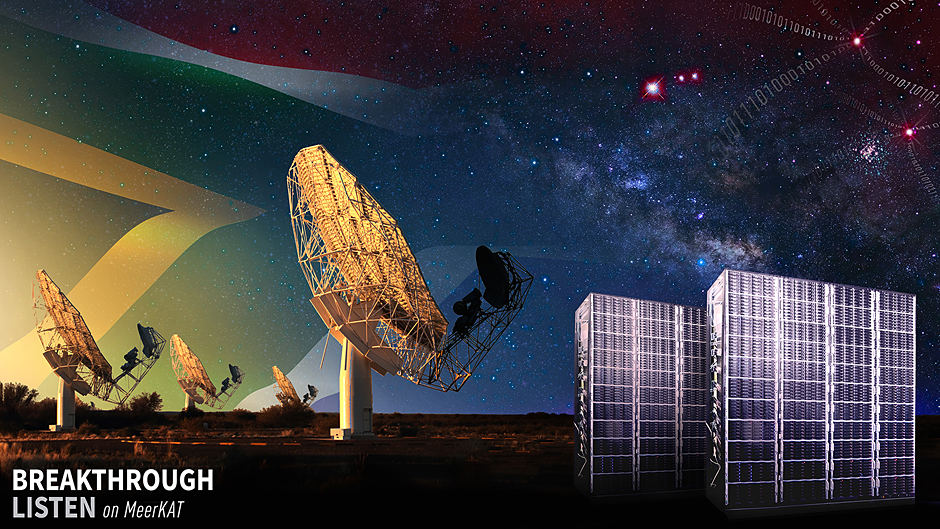At a powerful radio telescope, the hunt for signals from intelligent extraterrestrial life is on

A new initiative to search for signals from intelligent extraterrestrial life has kicked off at the Southern Hemisphere's largest radio telescope.
As part of the Breakthrough Listen project, a new supercomputer deployed at the MeerKAT radio telescope in the remote Karoo region of South Africa started looking for so-called technosignatures around a million nearby stars on Dec. 1.
The stars include those in the entire galactic plane of the Milky Way, with the additional power of MeerKAT increasing the number of targets included in the search by 1,000 times. The program also will look at 100 closer galaxies in a wide range of wavelengths of electromagnetic radiation, including radio waves and optical light.
Related: Why are we still searching for intelligent alien life?
It will take two years to search this population of stars, and in its routine observing mode, MeerKAT should be able to detect a transmitter similar to Earth's brightest radio beacons at 250 light-years away.
Keeping Earth's intelligent life busy
The development and installation of the most powerful digital instrumentation ever deployed in such a search has kept the Breakthrough Listen team occupied for the past three years. MeerKAT will join several other telescopes already involved with the project, including the Green Bank Telescope (GBT) in West Virginia and the Parkes telescope in Australia.
Unlike those other telescopes, however, MeerKAT won't mechanically move to look at targets all over the sky, because its field of view is already wide enough to encompass a large area containing plenty of stellar targets.
Get the Space.com Newsletter
Breaking space news, the latest updates on rocket launches, skywatching events and more!
"MeerKAT consists of 64 dishes, which can see an area of the sky 50 times bigger than the GBT can view at once," Breakthrough Listen principal investigator Andrew Siemion, director of the Berkeley SETI Research Center, said in a statement. "Such a large field of view typically contains many stars that are interesting technosignature targets. Our new supercomputer enables us to combine signals from the 64 dishes to get high-resolution scans of these targets with excellent sensitivity, all without impacting the research of other astronomers who are using the array."
By operating the telescope in the background in this way, Breakthrough Listen researchers will have access to MeerKAT's radio telescopes for almost 24 hours a day, seven days a week.
MeerKAT can scan 64 targets at one time in its main field of view, which means the telescope will help to eliminate signals originating from human-created technology, like satellites orbiting Earth.
To achieve this, the Breakthrough Listen team had to devise sophisticated targeting and scheduling software, as well as an automated data processing pipeline that scours information from MeerKAT in real time to hunt for interesting or unusual signals.
The Breakthrough Listen team has already identified a primary target.
"One of the first targets we'll be observing is our nearest neighbor star, Proxima Centauri, which appears to host two small, rocky planets in the star's habitable zone," the region around a star where liquid water can exist on a planet's surface, S. Pete Worden, executive director of Breakthrough Initiatives, said in the statement. "Routine observations with the Listen backend on MeerKAT are now underway, and the team looks forward to sharing the first science results in the coming months," he said.
Follow us on Twitter @Spacedotcom or on Facebook.
Join our Space Forums to keep talking space on the latest missions, night sky and more! And if you have a news tip, correction or comment, let us know at: community@space.com.

Robert Lea is a science journalist in the U.K. whose articles have been published in Physics World, New Scientist, Astronomy Magazine, All About Space, Newsweek and ZME Science. He also writes about science communication for Elsevier and the European Journal of Physics. Rob holds a bachelor of science degree in physics and astronomy from the U.K.’s Open University. Follow him on Twitter @sciencef1rst.
-
wxman2003 There is probably abundant life out there, the real issue is there may not be very much intelligent life. Life doesn't need intelligence to thrive.Reply -
karlp295 Is there any real reason to believe that if there are intelligent beings out there, and I believe there must be, why would they use radio to communicate?Reply









